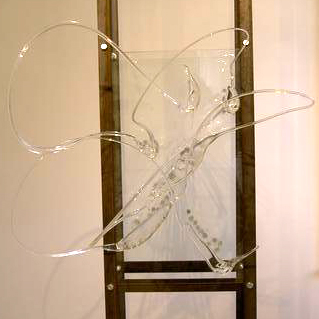About sho
Art of the line/ El arte de la línea
EN
SHO is an art of the line. What is the line? It is a mark that a brush and paper have touched. However, what can you see there? Not only do you see beauty of form drawn on paper, but also the motion before a brush touches paper, the speed and pressure of a brush touching paper, and movement and distance after a brush has been apart from paper. All of this makes up one line. We can relive the time that the artist spent and can feel even the artist’s emotion by chasing the line. The line is like a time travel machine. We can feel the artist’s breath from his or her works exceeding the age. Even if we don’t see the artist produce the work, we can still experience its creation.
Return your eyes on the entire work. Black lines and white space are there. This blank space is the most important thing in a Japanese sense of beauty. This blank is intentional. Japanese feel the sound of the lines and project their own feelings here. Now the work is completed at last.
After beginning to engrave characters on animals’ bones 4000 years ago, Chinese believe that characters have power and they have been valuing them. They pursued not only a practical side of characters to tell meanings correctly, but also the artistic side of them. They created various styles of characters over time. SHO has been developed mainly to draw characters beautifully in Japan as well.
I am trying however to be free from the restriction of “the meanings of characters” by giving more priority to another beauty of SHO, lines, and to convey my feelings straightly by SHO. I believe that this expression of the line, the pulse of life, is a primitive means that everyone can sympathize with without the language barrier.
ES
SHO es un arte de la línea. ¿Qué es la línea? Es una marca que un pincel y un papel han tocado. Sin embargo, ¿qué se puede ver ahí? No sólo se ve la belleza de la forma dibujada sobre el papel, sino también el movimiento antes de que un pincel toque el papel, la velocidad y la presión de un pincel al tocar el papel, y el movimiento y la distancia después de que un pincel se haya separado del papel. Todo esto conforma una línea. Podemos revivir el tiempo que pasó el artista y podemos sentir incluso la emoción del artista persiguiendo la línea. La línea es como una máquina de viajar en el tiempo. Podemos sentir el aliento del artista por sus obras que superan la época. Aunque no veamos al artista realizar la obra, podemos experimentar su creación.
Vuelve los ojos sobre toda la obra. Las líneas negras y el espacio en blanco están ahí. Este espacio en blanco es lo más importante en el sentido japonés de la belleza. Este espacio en blanco es intencionado. Los japoneses sienten el sonido de las líneas y proyectan aquí sus propios sentimientos. Ahora, por fin, el trabajo está terminado.
Después de empezar a grabar caracteres en huesos de animales hace 4000 años, los chinos creen que los caracteres tienen poder y los han estado valorando. No sólo buscaban el lado práctico de los caracteres para contar correctamente los significados, sino también su lado artístico. A lo largo del tiempo crearon varios estilos de caracteres. El SHO se ha desarrollado principalmente para dibujar personajes hermosos también en Japón.
Sin embargo, estoy intentando liberarme de la restricción de “los significados de los caracteres” dando más prioridad a otra belleza del SHO, las líneas, y transmitir mis sentimientos directamente mediante el SHO. Creo que esta expresión de la línea, el pulso de la vida, es un medio primitivo con el que todo el mundo puede simpatizar sin la barrera del idioma.
<Experimental work to communicate the essence of SHO>
This work expresses 2 aspects of a SHO work.
Left side : Glass shapes invisible lines between strokes consisting an ideogram. They are orbits of an artist’s brush.
Right side : This is an image of power going through the paper when an artist draws line. The power means the artist’s emotion.
Two glass plates are front and back sides of paper.
You can read a ideogram “光(hikari=light)” on these glasses.
This work was made in Glass studio TooS(Okayama, Japan) with Tsunehide Okamoto.
<Obra experimental para comunicar la esencia de SHO>
Esta obra expresa 2 aspectos de la obra de un SHO.

Lado izquierdo : El vidrio forma líneas invisibles entre los trazos que componen un ideograma. Son órbitas del pincel de un artista.
Lado derecho : Es una imagen de la fuerza que atraviesa el papel cuando un artista traza una línea. El poder significa la emoción del artista.

Dos placas de cristal son el anverso y el reverso del papel.
En estos cristales se puede leer un ideograma “光(hikari=luz)”.
Esta obra se realizó en el estudio de vidrio TooS (Okayama, Japón) con Tsunehide Okamoto.
